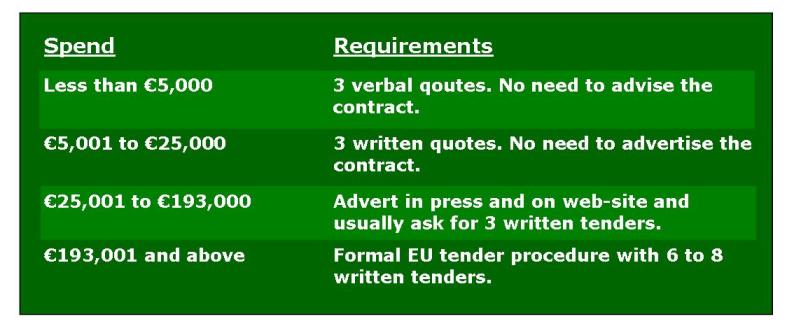Understand the buyer
Public sector buyers do not like risks. They are governed by many sets of rules laid down by the EU and government. No one in a public organisation wants to see their name spread across the local newspaper in a negative way. Here are some of the reasons for the rules:
- Avoid corruption by having a fair transparent process
- A fair process that is clear
- Reduce costs by looking at a range of competitive suppliers
- Look for new ideas
- Legal reasons – they must comply with legal procedures
In summary they are looking for the “best value” for their money from the “safest” pair of hands. This does not mean they are looking for the cheapest quote. The cheapest ones often go wrong and lead to more costs when the job is re-tendered.
They also have to follow EU and government instructions to “influence” suppliers. This is a way for governments to make sure business complies with new rules.
In recent years there has for example been a big focus on the sustainability agenda – minimising energy and water use, dispose of waste correctly, recycle more and so on. Other agendas to follow are such as equal opportunity laws, involvement of SMEs etc.
The public sector is one way in which these measures can be enforced. So a buyer from the public sector has to give contracts to companies that follow these rules. Many private companies also buy in the same way to ensure their supply chain is working according to the ethical and environmental standards.
Each buyer has guidelines to follow. The matrix below is an example from the United Kingdom of regional thresholds for supply of goods and services (buildings start at €4,845,000) showing the points where the rules change. Knowing these regional or national thresholds makes it easier for a SME to target the right buyer.
The matrix is an example of the purchasing guidelines for a small municipality. They are not the same across member states and it is important to find out the guidelines for the buyer you are selling to. Guidelines are normally found on the website of the organisation. (Some member states have the same guidelines for all their buyers.)
Looking at the table it is important to note that formal tender procedures do not start until there is a tender over €193,000. Below this figure there is a process but it is not as strict as the formal one.
It is also important to know that a 3 year training contract worth €80,000 a year is treated as a €240,000 contract for tender purposes (and therefore must comply with EU-rules).
Example of the purchasing guidelines for a small municipality in the United Kingdom:

Look for local guidelines in your region or municipality!
 |
 |
 |
 |